Understanding and Leading Change
VerifiedAdded on 2023/01/18
|18
|5294
|23
AI Summary
This report covers the impact of changes on the operations and activities of Vodafone, a UK based telecommunication business organisation, and the comparison between various organisations in the context of the impact of changes on their structure and operations.
Contribute Materials
Your contribution can guide someone’s learning journey. Share your
documents today.
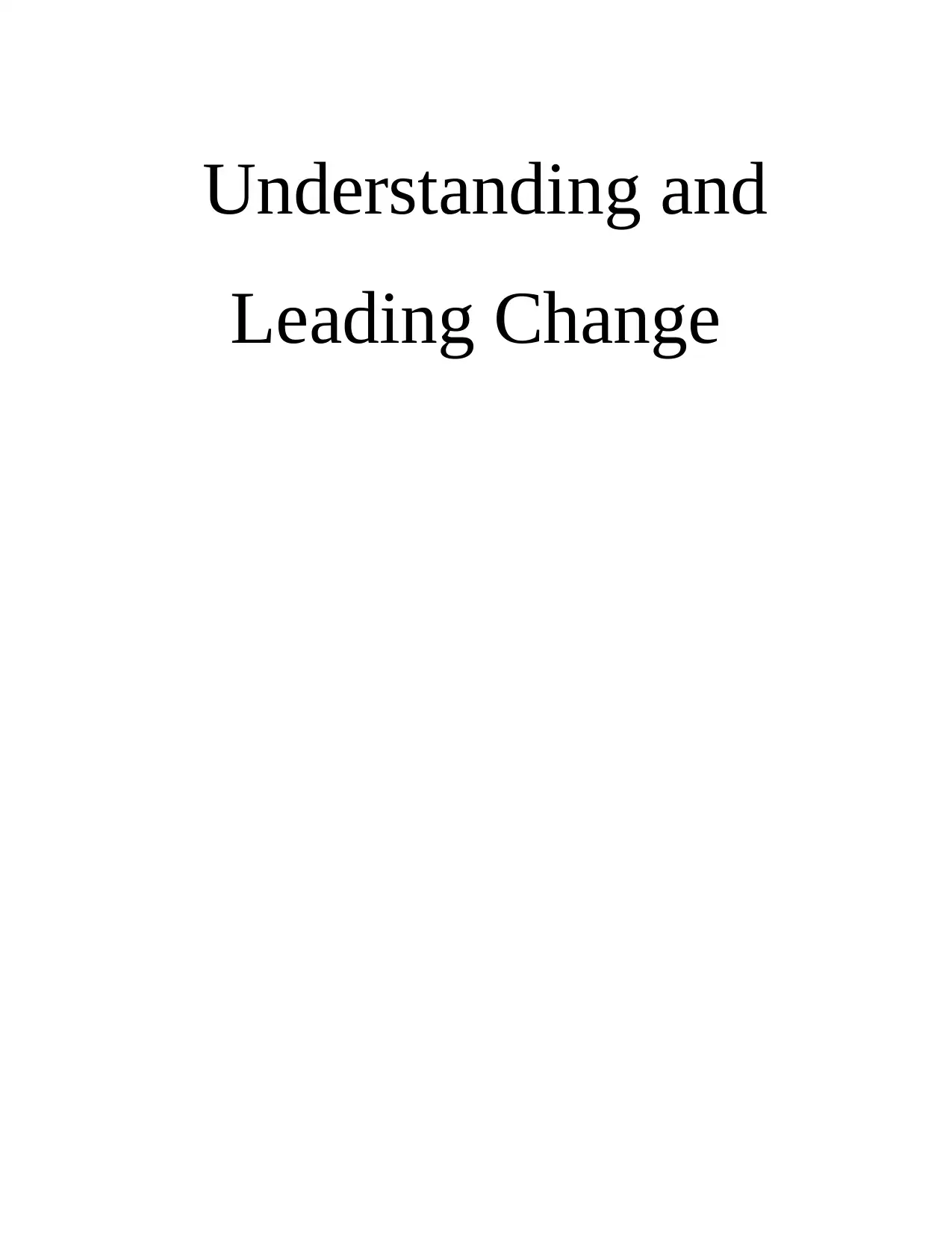
Understanding and
Leading Change
Leading Change
Secure Best Marks with AI Grader
Need help grading? Try our AI Grader for instant feedback on your assignments.
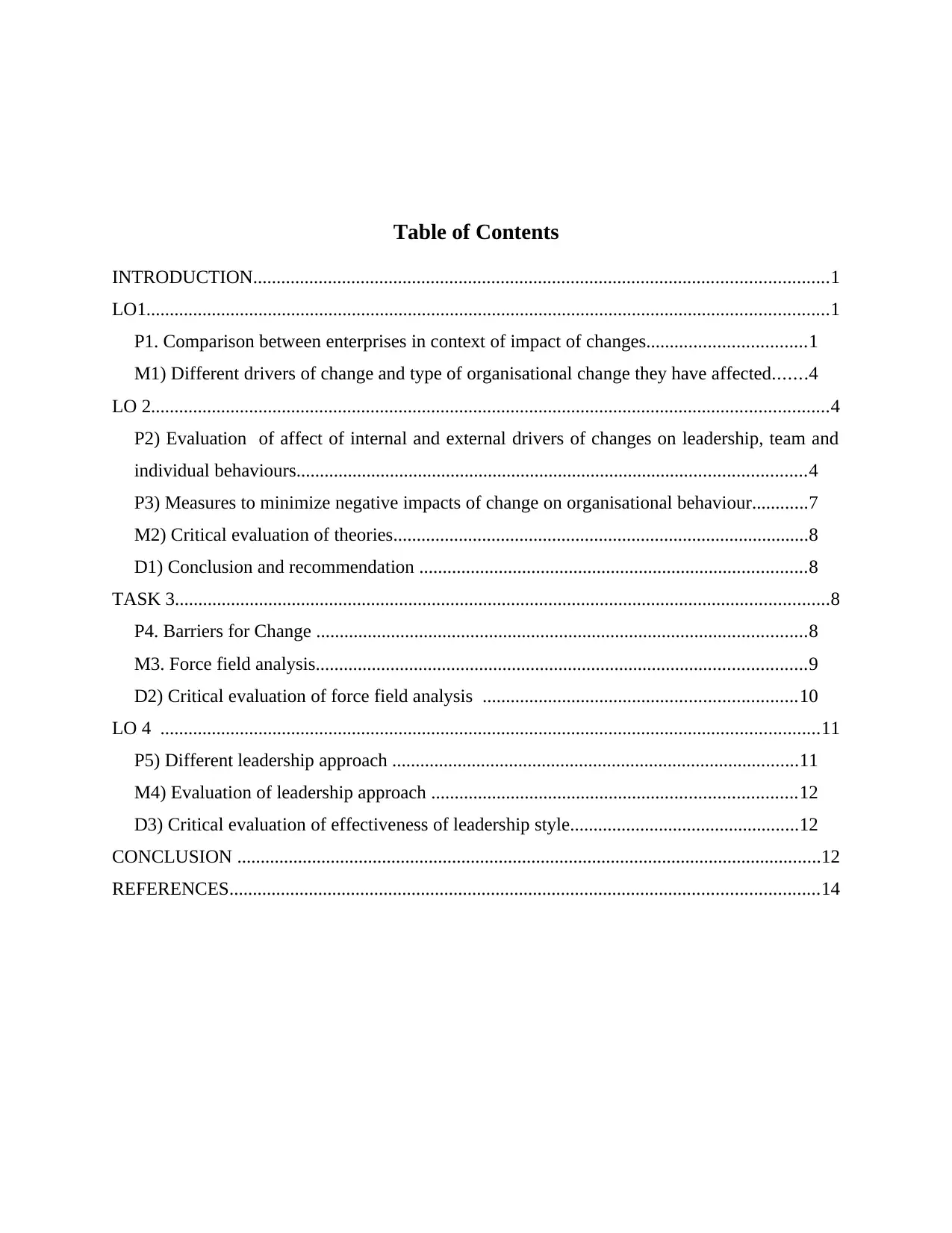
Table of Contents
INTRODUCTION...........................................................................................................................1
LO1..................................................................................................................................................1
P1. Comparison between enterprises in context of impact of changes..................................1
M1) Different drivers of change and type of organisational change they have affected.......4
LO 2.................................................................................................................................................4
P2) Evaluation of affect of internal and external drivers of changes on leadership, team and
individual behaviours.............................................................................................................4
P3) Measures to minimize negative impacts of change on organisational behaviour............7
M2) Critical evaluation of theories.........................................................................................8
D1) Conclusion and recommendation ...................................................................................8
TASK 3............................................................................................................................................8
P4. Barriers for Change .........................................................................................................8
M3. Force field analysis.........................................................................................................9
D2) Critical evaluation of force field analysis ...................................................................10
LO 4 .............................................................................................................................................11
P5) Different leadership approach .......................................................................................11
M4) Evaluation of leadership approach ..............................................................................12
D3) Critical evaluation of effectiveness of leadership style.................................................12
CONCLUSION .............................................................................................................................12
REFERENCES..............................................................................................................................14
INTRODUCTION...........................................................................................................................1
LO1..................................................................................................................................................1
P1. Comparison between enterprises in context of impact of changes..................................1
M1) Different drivers of change and type of organisational change they have affected.......4
LO 2.................................................................................................................................................4
P2) Evaluation of affect of internal and external drivers of changes on leadership, team and
individual behaviours.............................................................................................................4
P3) Measures to minimize negative impacts of change on organisational behaviour............7
M2) Critical evaluation of theories.........................................................................................8
D1) Conclusion and recommendation ...................................................................................8
TASK 3............................................................................................................................................8
P4. Barriers for Change .........................................................................................................8
M3. Force field analysis.........................................................................................................9
D2) Critical evaluation of force field analysis ...................................................................10
LO 4 .............................................................................................................................................11
P5) Different leadership approach .......................................................................................11
M4) Evaluation of leadership approach ..............................................................................12
D3) Critical evaluation of effectiveness of leadership style.................................................12
CONCLUSION .............................................................................................................................12
REFERENCES..............................................................................................................................14

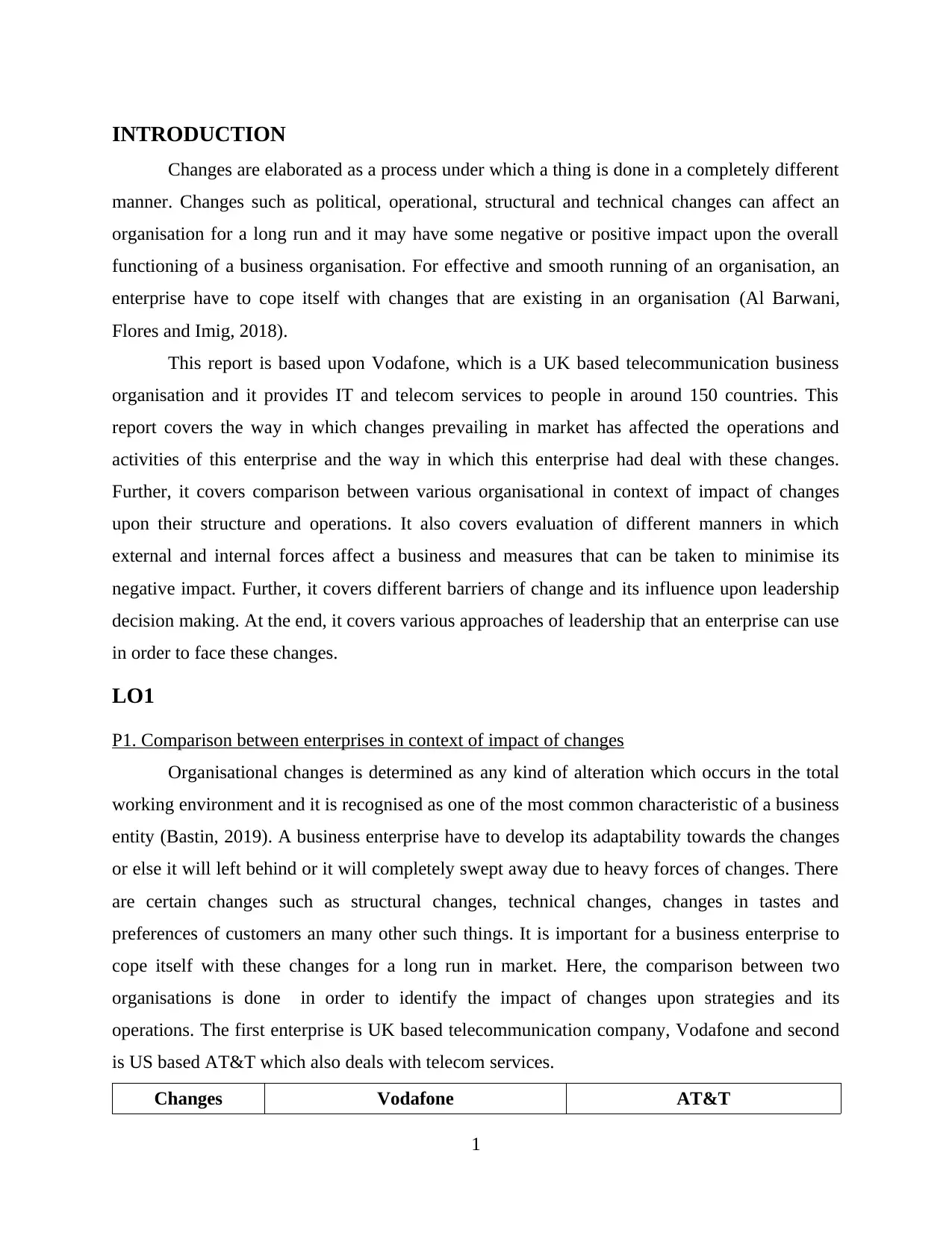
INTRODUCTION
Changes are elaborated as a process under which a thing is done in a completely different
manner. Changes such as political, operational, structural and technical changes can affect an
organisation for a long run and it may have some negative or positive impact upon the overall
functioning of a business organisation. For effective and smooth running of an organisation, an
enterprise have to cope itself with changes that are existing in an organisation (Al Barwani,
Flores and Imig, 2018).
This report is based upon Vodafone, which is a UK based telecommunication business
organisation and it provides IT and telecom services to people in around 150 countries. This
report covers the way in which changes prevailing in market has affected the operations and
activities of this enterprise and the way in which this enterprise had deal with these changes.
Further, it covers comparison between various organisational in context of impact of changes
upon their structure and operations. It also covers evaluation of different manners in which
external and internal forces affect a business and measures that can be taken to minimise its
negative impact. Further, it covers different barriers of change and its influence upon leadership
decision making. At the end, it covers various approaches of leadership that an enterprise can use
in order to face these changes.
LO1
P1. Comparison between enterprises in context of impact of changes
Organisational changes is determined as any kind of alteration which occurs in the total
working environment and it is recognised as one of the most common characteristic of a business
entity (Bastin, 2019). A business enterprise have to develop its adaptability towards the changes
or else it will left behind or it will completely swept away due to heavy forces of changes. There
are certain changes such as structural changes, technical changes, changes in tastes and
preferences of customers an many other such things. It is important for a business enterprise to
cope itself with these changes for a long run in market. Here, the comparison between two
organisations is done in order to identify the impact of changes upon strategies and its
operations. The first enterprise is UK based telecommunication company, Vodafone and second
is US based AT&T which also deals with telecom services.
Changes Vodafone AT&T
1
Changes are elaborated as a process under which a thing is done in a completely different
manner. Changes such as political, operational, structural and technical changes can affect an
organisation for a long run and it may have some negative or positive impact upon the overall
functioning of a business organisation. For effective and smooth running of an organisation, an
enterprise have to cope itself with changes that are existing in an organisation (Al Barwani,
Flores and Imig, 2018).
This report is based upon Vodafone, which is a UK based telecommunication business
organisation and it provides IT and telecom services to people in around 150 countries. This
report covers the way in which changes prevailing in market has affected the operations and
activities of this enterprise and the way in which this enterprise had deal with these changes.
Further, it covers comparison between various organisational in context of impact of changes
upon their structure and operations. It also covers evaluation of different manners in which
external and internal forces affect a business and measures that can be taken to minimise its
negative impact. Further, it covers different barriers of change and its influence upon leadership
decision making. At the end, it covers various approaches of leadership that an enterprise can use
in order to face these changes.
LO1
P1. Comparison between enterprises in context of impact of changes
Organisational changes is determined as any kind of alteration which occurs in the total
working environment and it is recognised as one of the most common characteristic of a business
entity (Bastin, 2019). A business enterprise have to develop its adaptability towards the changes
or else it will left behind or it will completely swept away due to heavy forces of changes. There
are certain changes such as structural changes, technical changes, changes in tastes and
preferences of customers an many other such things. It is important for a business enterprise to
cope itself with these changes for a long run in market. Here, the comparison between two
organisations is done in order to identify the impact of changes upon strategies and its
operations. The first enterprise is UK based telecommunication company, Vodafone and second
is US based AT&T which also deals with telecom services.
Changes Vodafone AT&T
1
Secure Best Marks with AI Grader
Need help grading? Try our AI Grader for instant feedback on your assignments.
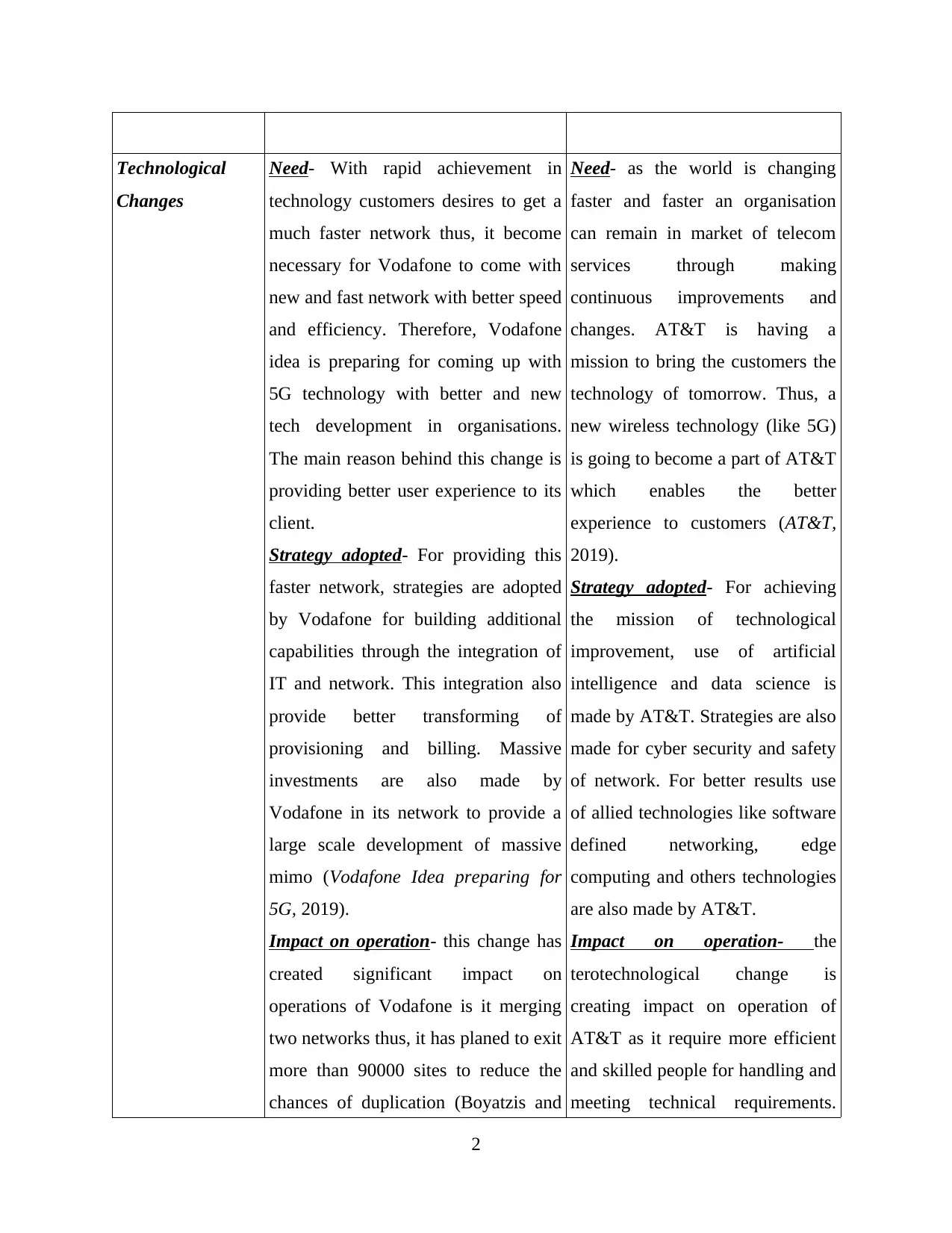
Technological
Changes
Need- With rapid achievement in
technology customers desires to get a
much faster network thus, it become
necessary for Vodafone to come with
new and fast network with better speed
and efficiency. Therefore, Vodafone
idea is preparing for coming up with
5G technology with better and new
tech development in organisations.
The main reason behind this change is
providing better user experience to its
client.
Strategy adopted- For providing this
faster network, strategies are adopted
by Vodafone for building additional
capabilities through the integration of
IT and network. This integration also
provide better transforming of
provisioning and billing. Massive
investments are also made by
Vodafone in its network to provide a
large scale development of massive
mimo (Vodafone Idea preparing for
5G, 2019).
Impact on operation- this change has
created significant impact on
operations of Vodafone is it merging
two networks thus, it has planed to exit
more than 90000 sites to reduce the
chances of duplication (Boyatzis and
Need- as the world is changing
faster and faster an organisation
can remain in market of telecom
services through making
continuous improvements and
changes. AT&T is having a
mission to bring the customers the
technology of tomorrow. Thus, a
new wireless technology (like 5G)
is going to become a part of AT&T
which enables the better
experience to customers (AT&T,
2019).
Strategy adopted- For achieving
the mission of technological
improvement, use of artificial
intelligence and data science is
made by AT&T. Strategies are also
made for cyber security and safety
of network. For better results use
of allied technologies like software
defined networking, edge
computing and others technologies
are also made by AT&T.
Impact on operation- the
terotechnological change is
creating impact on operation of
AT&T as it require more efficient
and skilled people for handling and
meeting technical requirements.
2
Changes
Need- With rapid achievement in
technology customers desires to get a
much faster network thus, it become
necessary for Vodafone to come with
new and fast network with better speed
and efficiency. Therefore, Vodafone
idea is preparing for coming up with
5G technology with better and new
tech development in organisations.
The main reason behind this change is
providing better user experience to its
client.
Strategy adopted- For providing this
faster network, strategies are adopted
by Vodafone for building additional
capabilities through the integration of
IT and network. This integration also
provide better transforming of
provisioning and billing. Massive
investments are also made by
Vodafone in its network to provide a
large scale development of massive
mimo (Vodafone Idea preparing for
5G, 2019).
Impact on operation- this change has
created significant impact on
operations of Vodafone is it merging
two networks thus, it has planed to exit
more than 90000 sites to reduce the
chances of duplication (Boyatzis and
Need- as the world is changing
faster and faster an organisation
can remain in market of telecom
services through making
continuous improvements and
changes. AT&T is having a
mission to bring the customers the
technology of tomorrow. Thus, a
new wireless technology (like 5G)
is going to become a part of AT&T
which enables the better
experience to customers (AT&T,
2019).
Strategy adopted- For achieving
the mission of technological
improvement, use of artificial
intelligence and data science is
made by AT&T. Strategies are also
made for cyber security and safety
of network. For better results use
of allied technologies like software
defined networking, edge
computing and others technologies
are also made by AT&T.
Impact on operation- the
terotechnological change is
creating impact on operation of
AT&T as it require more efficient
and skilled people for handling and
meeting technical requirements.
2
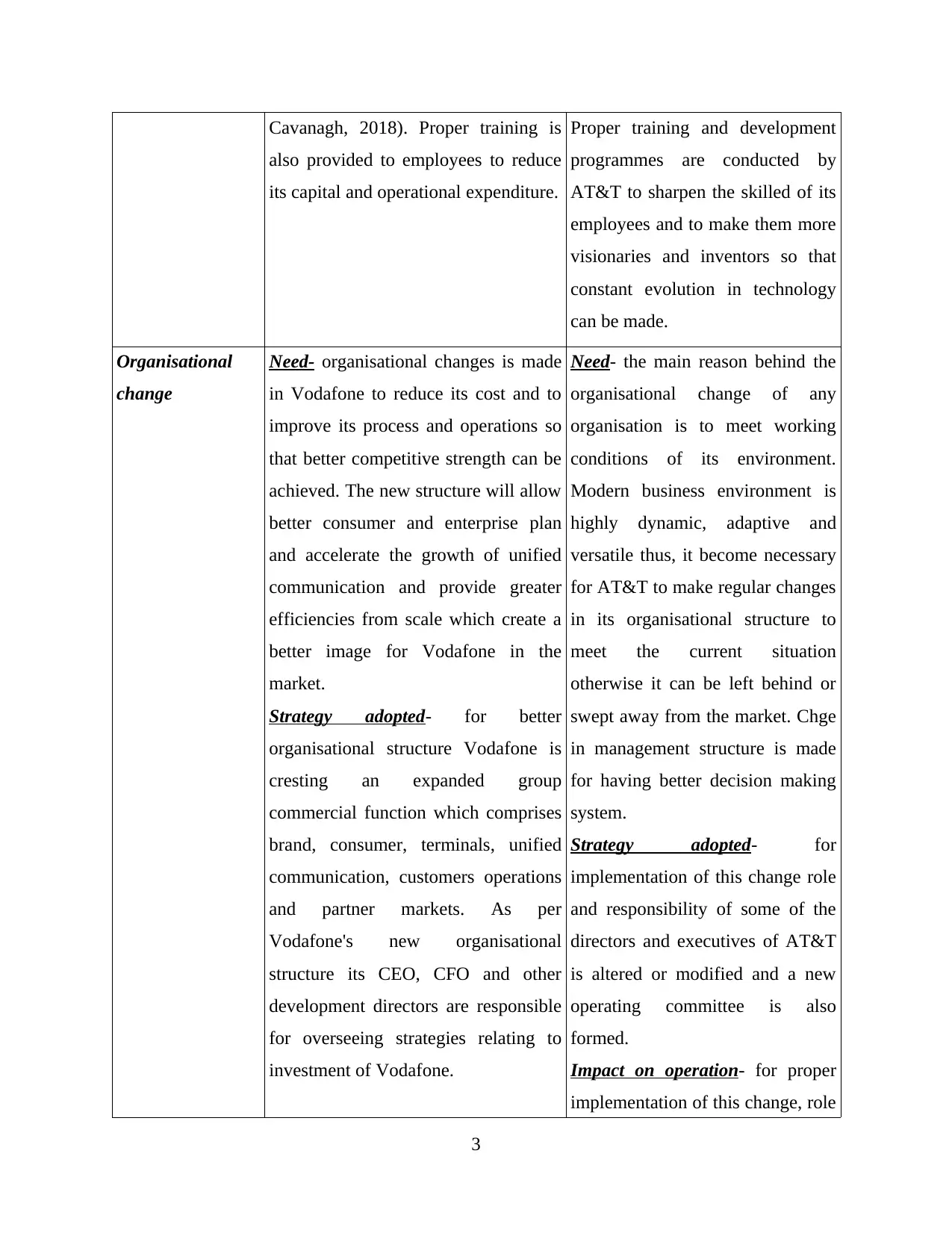
Cavanagh, 2018). Proper training is
also provided to employees to reduce
its capital and operational expenditure.
Proper training and development
programmes are conducted by
AT&T to sharpen the skilled of its
employees and to make them more
visionaries and inventors so that
constant evolution in technology
can be made.
Organisational
change
Need- organisational changes is made
in Vodafone to reduce its cost and to
improve its process and operations so
that better competitive strength can be
achieved. The new structure will allow
better consumer and enterprise plan
and accelerate the growth of unified
communication and provide greater
efficiencies from scale which create a
better image for Vodafone in the
market.
Strategy adopted- for better
organisational structure Vodafone is
cresting an expanded group
commercial function which comprises
brand, consumer, terminals, unified
communication, customers operations
and partner markets. As per
Vodafone's new organisational
structure its CEO, CFO and other
development directors are responsible
for overseeing strategies relating to
investment of Vodafone.
Need- the main reason behind the
organisational change of any
organisation is to meet working
conditions of its environment.
Modern business environment is
highly dynamic, adaptive and
versatile thus, it become necessary
for AT&T to make regular changes
in its organisational structure to
meet the current situation
otherwise it can be left behind or
swept away from the market. Chge
in management structure is made
for having better decision making
system.
Strategy adopted- for
implementation of this change role
and responsibility of some of the
directors and executives of AT&T
is altered or modified and a new
operating committee is also
formed.
Impact on operation- for proper
implementation of this change, role
3
also provided to employees to reduce
its capital and operational expenditure.
Proper training and development
programmes are conducted by
AT&T to sharpen the skilled of its
employees and to make them more
visionaries and inventors so that
constant evolution in technology
can be made.
Organisational
change
Need- organisational changes is made
in Vodafone to reduce its cost and to
improve its process and operations so
that better competitive strength can be
achieved. The new structure will allow
better consumer and enterprise plan
and accelerate the growth of unified
communication and provide greater
efficiencies from scale which create a
better image for Vodafone in the
market.
Strategy adopted- for better
organisational structure Vodafone is
cresting an expanded group
commercial function which comprises
brand, consumer, terminals, unified
communication, customers operations
and partner markets. As per
Vodafone's new organisational
structure its CEO, CFO and other
development directors are responsible
for overseeing strategies relating to
investment of Vodafone.
Need- the main reason behind the
organisational change of any
organisation is to meet working
conditions of its environment.
Modern business environment is
highly dynamic, adaptive and
versatile thus, it become necessary
for AT&T to make regular changes
in its organisational structure to
meet the current situation
otherwise it can be left behind or
swept away from the market. Chge
in management structure is made
for having better decision making
system.
Strategy adopted- for
implementation of this change role
and responsibility of some of the
directors and executives of AT&T
is altered or modified and a new
operating committee is also
formed.
Impact on operation- for proper
implementation of this change, role
3
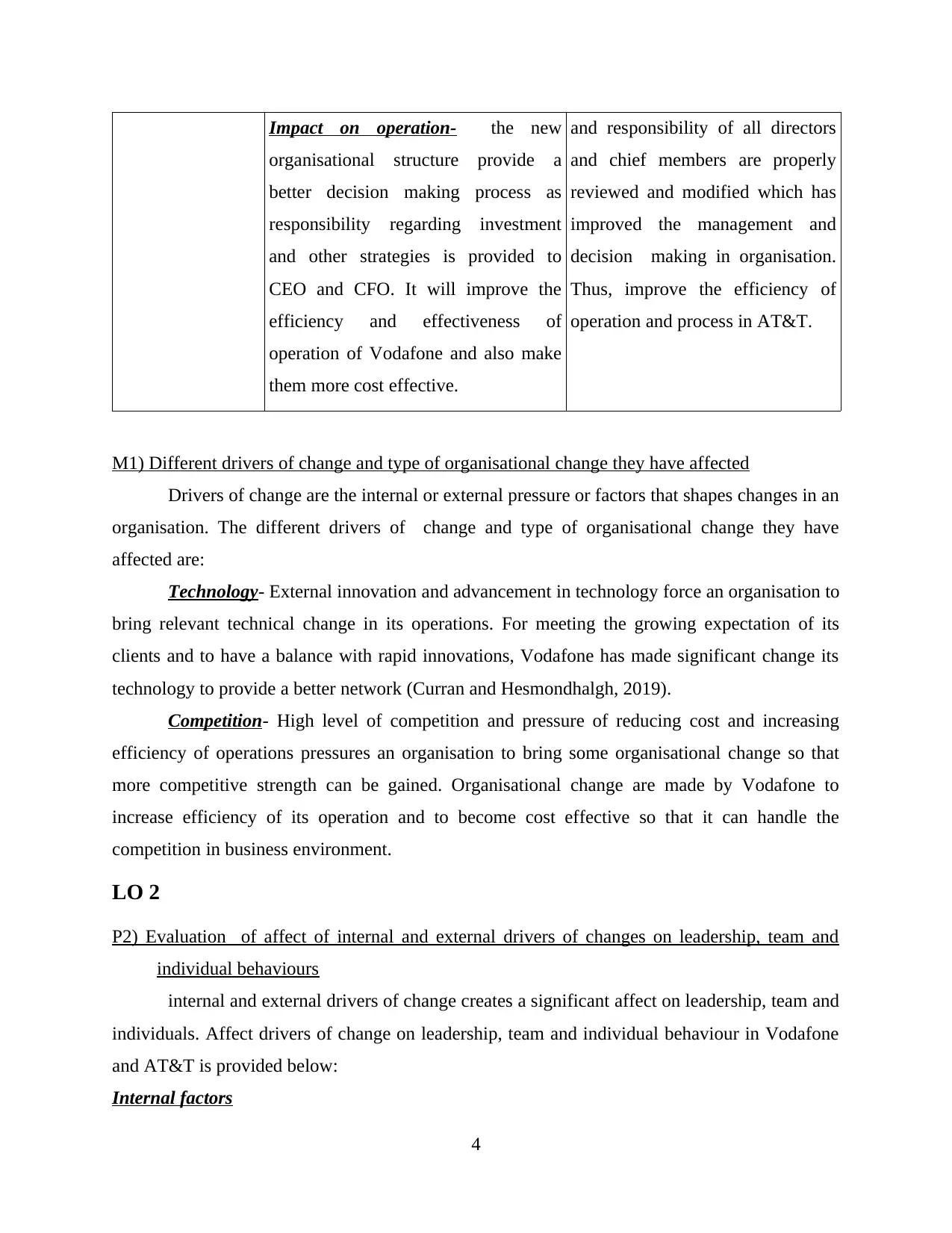
Impact on operation- the new
organisational structure provide a
better decision making process as
responsibility regarding investment
and other strategies is provided to
CEO and CFO. It will improve the
efficiency and effectiveness of
operation of Vodafone and also make
them more cost effective.
and responsibility of all directors
and chief members are properly
reviewed and modified which has
improved the management and
decision making in organisation.
Thus, improve the efficiency of
operation and process in AT&T.
M1) Different drivers of change and type of organisational change they have affected
Drivers of change are the internal or external pressure or factors that shapes changes in an
organisation. The different drivers of change and type of organisational change they have
affected are:
Technology- External innovation and advancement in technology force an organisation to
bring relevant technical change in its operations. For meeting the growing expectation of its
clients and to have a balance with rapid innovations, Vodafone has made significant change its
technology to provide a better network (Curran and Hesmondhalgh, 2019).
Competition- High level of competition and pressure of reducing cost and increasing
efficiency of operations pressures an organisation to bring some organisational change so that
more competitive strength can be gained. Organisational change are made by Vodafone to
increase efficiency of its operation and to become cost effective so that it can handle the
competition in business environment.
LO 2
P2) Evaluation of affect of internal and external drivers of changes on leadership, team and
individual behaviours
internal and external drivers of change creates a significant affect on leadership, team and
individuals. Affect drivers of change on leadership, team and individual behaviour in Vodafone
and AT&T is provided below:
Internal factors
4
organisational structure provide a
better decision making process as
responsibility regarding investment
and other strategies is provided to
CEO and CFO. It will improve the
efficiency and effectiveness of
operation of Vodafone and also make
them more cost effective.
and responsibility of all directors
and chief members are properly
reviewed and modified which has
improved the management and
decision making in organisation.
Thus, improve the efficiency of
operation and process in AT&T.
M1) Different drivers of change and type of organisational change they have affected
Drivers of change are the internal or external pressure or factors that shapes changes in an
organisation. The different drivers of change and type of organisational change they have
affected are:
Technology- External innovation and advancement in technology force an organisation to
bring relevant technical change in its operations. For meeting the growing expectation of its
clients and to have a balance with rapid innovations, Vodafone has made significant change its
technology to provide a better network (Curran and Hesmondhalgh, 2019).
Competition- High level of competition and pressure of reducing cost and increasing
efficiency of operations pressures an organisation to bring some organisational change so that
more competitive strength can be gained. Organisational change are made by Vodafone to
increase efficiency of its operation and to become cost effective so that it can handle the
competition in business environment.
LO 2
P2) Evaluation of affect of internal and external drivers of changes on leadership, team and
individual behaviours
internal and external drivers of change creates a significant affect on leadership, team and
individuals. Affect drivers of change on leadership, team and individual behaviour in Vodafone
and AT&T is provided below:
Internal factors
4
Paraphrase This Document
Need a fresh take? Get an instant paraphrase of this document with our AI Paraphraser
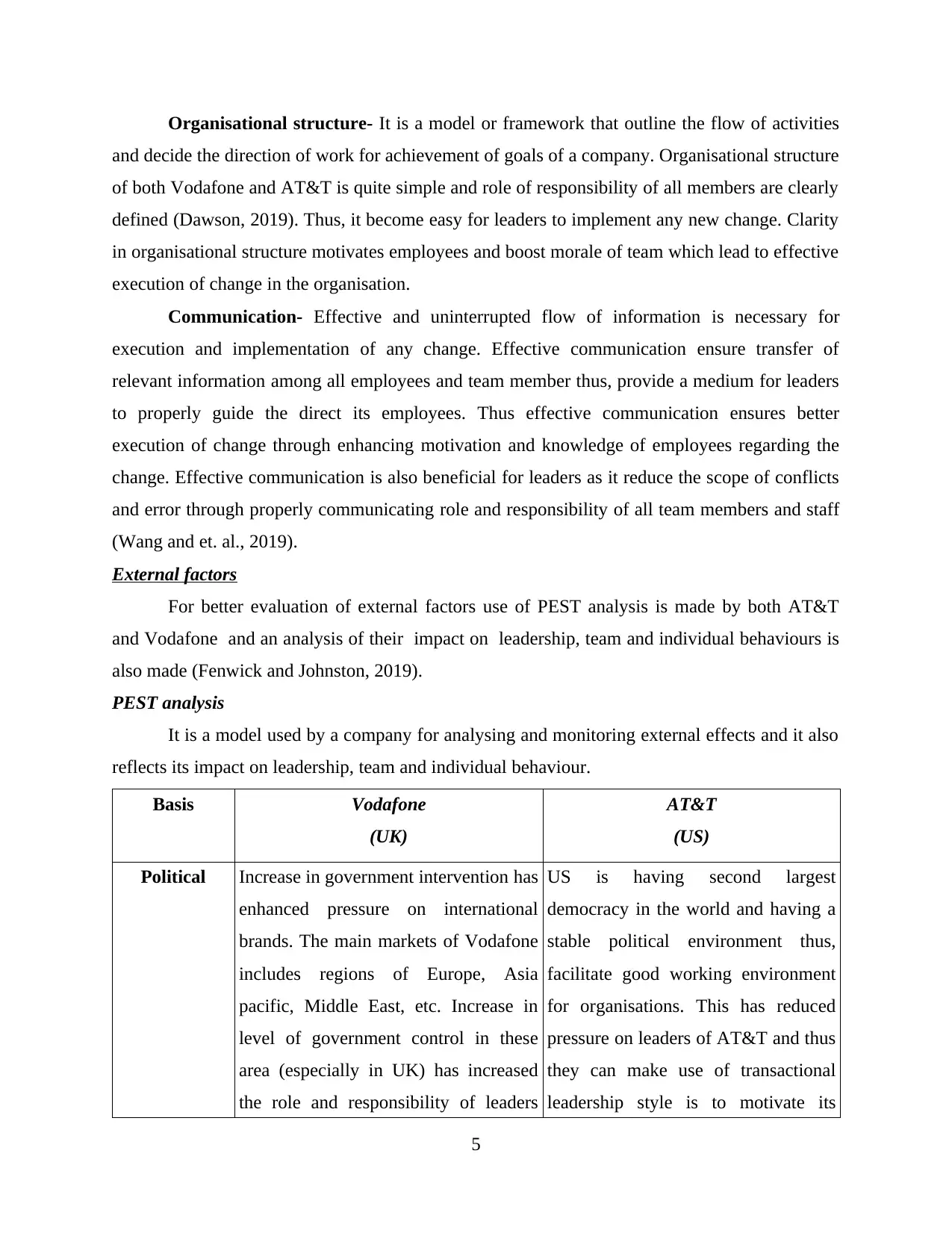
Organisational structure- It is a model or framework that outline the flow of activities
and decide the direction of work for achievement of goals of a company. Organisational structure
of both Vodafone and AT&T is quite simple and role of responsibility of all members are clearly
defined (Dawson, 2019). Thus, it become easy for leaders to implement any new change. Clarity
in organisational structure motivates employees and boost morale of team which lead to effective
execution of change in the organisation.
Communication- Effective and uninterrupted flow of information is necessary for
execution and implementation of any change. Effective communication ensure transfer of
relevant information among all employees and team member thus, provide a medium for leaders
to properly guide the direct its employees. Thus effective communication ensures better
execution of change through enhancing motivation and knowledge of employees regarding the
change. Effective communication is also beneficial for leaders as it reduce the scope of conflicts
and error through properly communicating role and responsibility of all team members and staff
(Wang and et. al., 2019).
External factors
For better evaluation of external factors use of PEST analysis is made by both AT&T
and Vodafone and an analysis of their impact on leadership, team and individual behaviours is
also made (Fenwick and Johnston, 2019).
PEST analysis
It is a model used by a company for analysing and monitoring external effects and it also
reflects its impact on leadership, team and individual behaviour.
Basis Vodafone
(UK)
AT&T
(US)
Political Increase in government intervention has
enhanced pressure on international
brands. The main markets of Vodafone
includes regions of Europe, Asia
pacific, Middle East, etc. Increase in
level of government control in these
area (especially in UK) has increased
the role and responsibility of leaders
US is having second largest
democracy in the world and having a
stable political environment thus,
facilitate good working environment
for organisations. This has reduced
pressure on leaders of AT&T and thus
they can make use of transactional
leadership style is to motivate its
5
and decide the direction of work for achievement of goals of a company. Organisational structure
of both Vodafone and AT&T is quite simple and role of responsibility of all members are clearly
defined (Dawson, 2019). Thus, it become easy for leaders to implement any new change. Clarity
in organisational structure motivates employees and boost morale of team which lead to effective
execution of change in the organisation.
Communication- Effective and uninterrupted flow of information is necessary for
execution and implementation of any change. Effective communication ensure transfer of
relevant information among all employees and team member thus, provide a medium for leaders
to properly guide the direct its employees. Thus effective communication ensures better
execution of change through enhancing motivation and knowledge of employees regarding the
change. Effective communication is also beneficial for leaders as it reduce the scope of conflicts
and error through properly communicating role and responsibility of all team members and staff
(Wang and et. al., 2019).
External factors
For better evaluation of external factors use of PEST analysis is made by both AT&T
and Vodafone and an analysis of their impact on leadership, team and individual behaviours is
also made (Fenwick and Johnston, 2019).
PEST analysis
It is a model used by a company for analysing and monitoring external effects and it also
reflects its impact on leadership, team and individual behaviour.
Basis Vodafone
(UK)
AT&T
(US)
Political Increase in government intervention has
enhanced pressure on international
brands. The main markets of Vodafone
includes regions of Europe, Asia
pacific, Middle East, etc. Increase in
level of government control in these
area (especially in UK) has increased
the role and responsibility of leaders
US is having second largest
democracy in the world and having a
stable political environment thus,
facilitate good working environment
for organisations. This has reduced
pressure on leaders of AT&T and thus
they can make use of transactional
leadership style is to motivate its
5
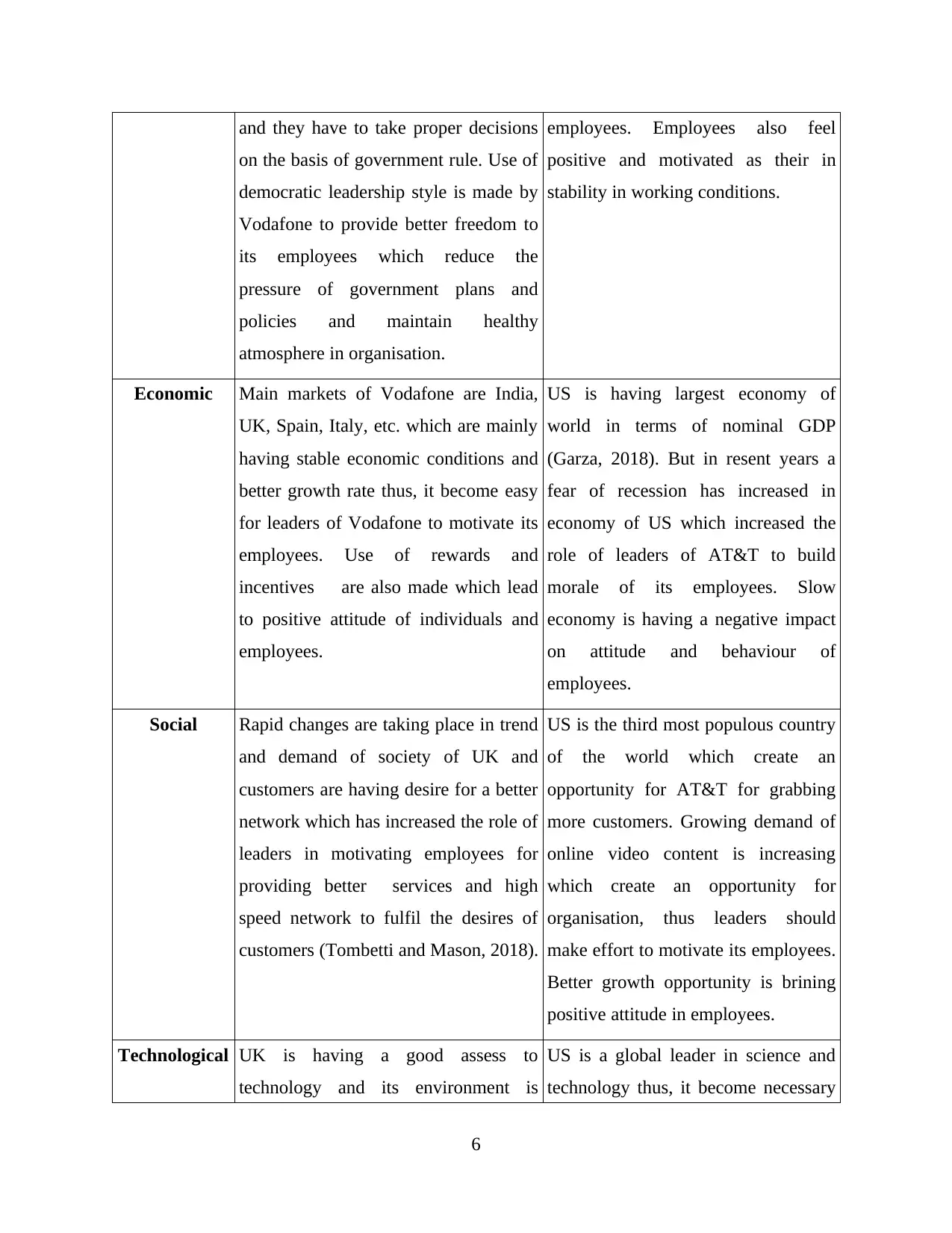
and they have to take proper decisions
on the basis of government rule. Use of
democratic leadership style is made by
Vodafone to provide better freedom to
its employees which reduce the
pressure of government plans and
policies and maintain healthy
atmosphere in organisation.
employees. Employees also feel
positive and motivated as their in
stability in working conditions.
Economic Main markets of Vodafone are India,
UK, Spain, Italy, etc. which are mainly
having stable economic conditions and
better growth rate thus, it become easy
for leaders of Vodafone to motivate its
employees. Use of rewards and
incentives are also made which lead
to positive attitude of individuals and
employees.
US is having largest economy of
world in terms of nominal GDP
(Garza, 2018). But in resent years a
fear of recession has increased in
economy of US which increased the
role of leaders of AT&T to build
morale of its employees. Slow
economy is having a negative impact
on attitude and behaviour of
employees.
Social Rapid changes are taking place in trend
and demand of society of UK and
customers are having desire for a better
network which has increased the role of
leaders in motivating employees for
providing better services and high
speed network to fulfil the desires of
customers (Tombetti and Mason, 2018).
US is the third most populous country
of the world which create an
opportunity for AT&T for grabbing
more customers. Growing demand of
online video content is increasing
which create an opportunity for
organisation, thus leaders should
make effort to motivate its employees.
Better growth opportunity is brining
positive attitude in employees.
Technological UK is having a good assess to
technology and its environment is
US is a global leader in science and
technology thus, it become necessary
6
on the basis of government rule. Use of
democratic leadership style is made by
Vodafone to provide better freedom to
its employees which reduce the
pressure of government plans and
policies and maintain healthy
atmosphere in organisation.
employees. Employees also feel
positive and motivated as their in
stability in working conditions.
Economic Main markets of Vodafone are India,
UK, Spain, Italy, etc. which are mainly
having stable economic conditions and
better growth rate thus, it become easy
for leaders of Vodafone to motivate its
employees. Use of rewards and
incentives are also made which lead
to positive attitude of individuals and
employees.
US is having largest economy of
world in terms of nominal GDP
(Garza, 2018). But in resent years a
fear of recession has increased in
economy of US which increased the
role of leaders of AT&T to build
morale of its employees. Slow
economy is having a negative impact
on attitude and behaviour of
employees.
Social Rapid changes are taking place in trend
and demand of society of UK and
customers are having desire for a better
network which has increased the role of
leaders in motivating employees for
providing better services and high
speed network to fulfil the desires of
customers (Tombetti and Mason, 2018).
US is the third most populous country
of the world which create an
opportunity for AT&T for grabbing
more customers. Growing demand of
online video content is increasing
which create an opportunity for
organisation, thus leaders should
make effort to motivate its employees.
Better growth opportunity is brining
positive attitude in employees.
Technological UK is having a good assess to
technology and its environment is
US is a global leader in science and
technology thus, it become necessary
6
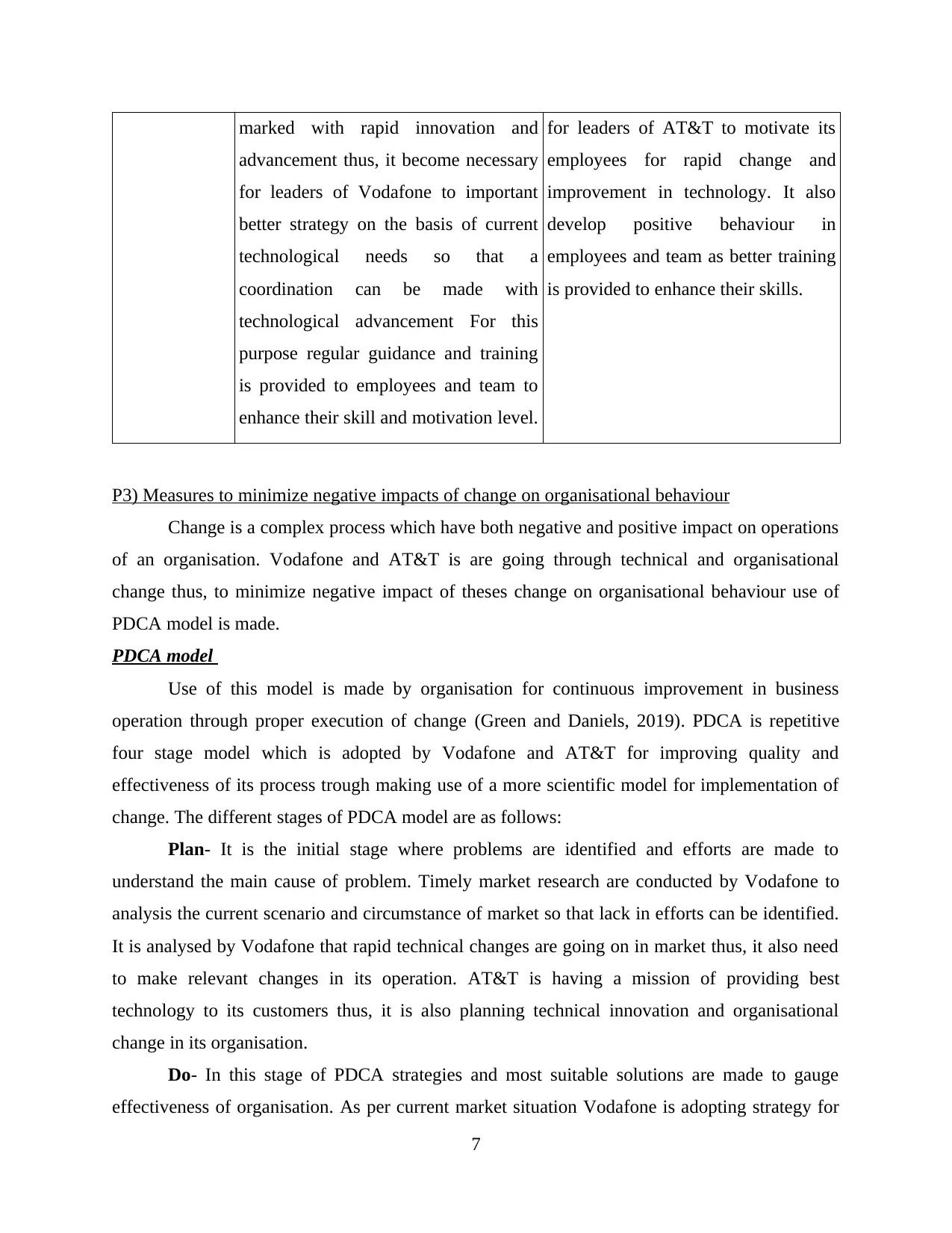
marked with rapid innovation and
advancement thus, it become necessary
for leaders of Vodafone to important
better strategy on the basis of current
technological needs so that a
coordination can be made with
technological advancement For this
purpose regular guidance and training
is provided to employees and team to
enhance their skill and motivation level.
for leaders of AT&T to motivate its
employees for rapid change and
improvement in technology. It also
develop positive behaviour in
employees and team as better training
is provided to enhance their skills.
P3) Measures to minimize negative impacts of change on organisational behaviour
Change is a complex process which have both negative and positive impact on operations
of an organisation. Vodafone and AT&T is are going through technical and organisational
change thus, to minimize negative impact of theses change on organisational behaviour use of
PDCA model is made.
PDCA model
Use of this model is made by organisation for continuous improvement in business
operation through proper execution of change (Green and Daniels, 2019). PDCA is repetitive
four stage model which is adopted by Vodafone and AT&T for improving quality and
effectiveness of its process trough making use of a more scientific model for implementation of
change. The different stages of PDCA model are as follows:
Plan- It is the initial stage where problems are identified and efforts are made to
understand the main cause of problem. Timely market research are conducted by Vodafone to
analysis the current scenario and circumstance of market so that lack in efforts can be identified.
It is analysed by Vodafone that rapid technical changes are going on in market thus, it also need
to make relevant changes in its operation. AT&T is having a mission of providing best
technology to its customers thus, it is also planning technical innovation and organisational
change in its organisation.
Do- In this stage of PDCA strategies and most suitable solutions are made to gauge
effectiveness of organisation. As per current market situation Vodafone is adopting strategy for
7
advancement thus, it become necessary
for leaders of Vodafone to important
better strategy on the basis of current
technological needs so that a
coordination can be made with
technological advancement For this
purpose regular guidance and training
is provided to employees and team to
enhance their skill and motivation level.
for leaders of AT&T to motivate its
employees for rapid change and
improvement in technology. It also
develop positive behaviour in
employees and team as better training
is provided to enhance their skills.
P3) Measures to minimize negative impacts of change on organisational behaviour
Change is a complex process which have both negative and positive impact on operations
of an organisation. Vodafone and AT&T is are going through technical and organisational
change thus, to minimize negative impact of theses change on organisational behaviour use of
PDCA model is made.
PDCA model
Use of this model is made by organisation for continuous improvement in business
operation through proper execution of change (Green and Daniels, 2019). PDCA is repetitive
four stage model which is adopted by Vodafone and AT&T for improving quality and
effectiveness of its process trough making use of a more scientific model for implementation of
change. The different stages of PDCA model are as follows:
Plan- It is the initial stage where problems are identified and efforts are made to
understand the main cause of problem. Timely market research are conducted by Vodafone to
analysis the current scenario and circumstance of market so that lack in efforts can be identified.
It is analysed by Vodafone that rapid technical changes are going on in market thus, it also need
to make relevant changes in its operation. AT&T is having a mission of providing best
technology to its customers thus, it is also planning technical innovation and organisational
change in its organisation.
Do- In this stage of PDCA strategies and most suitable solutions are made to gauge
effectiveness of organisation. As per current market situation Vodafone is adopting strategy for
7
Secure Best Marks with AI Grader
Need help grading? Try our AI Grader for instant feedback on your assignments.
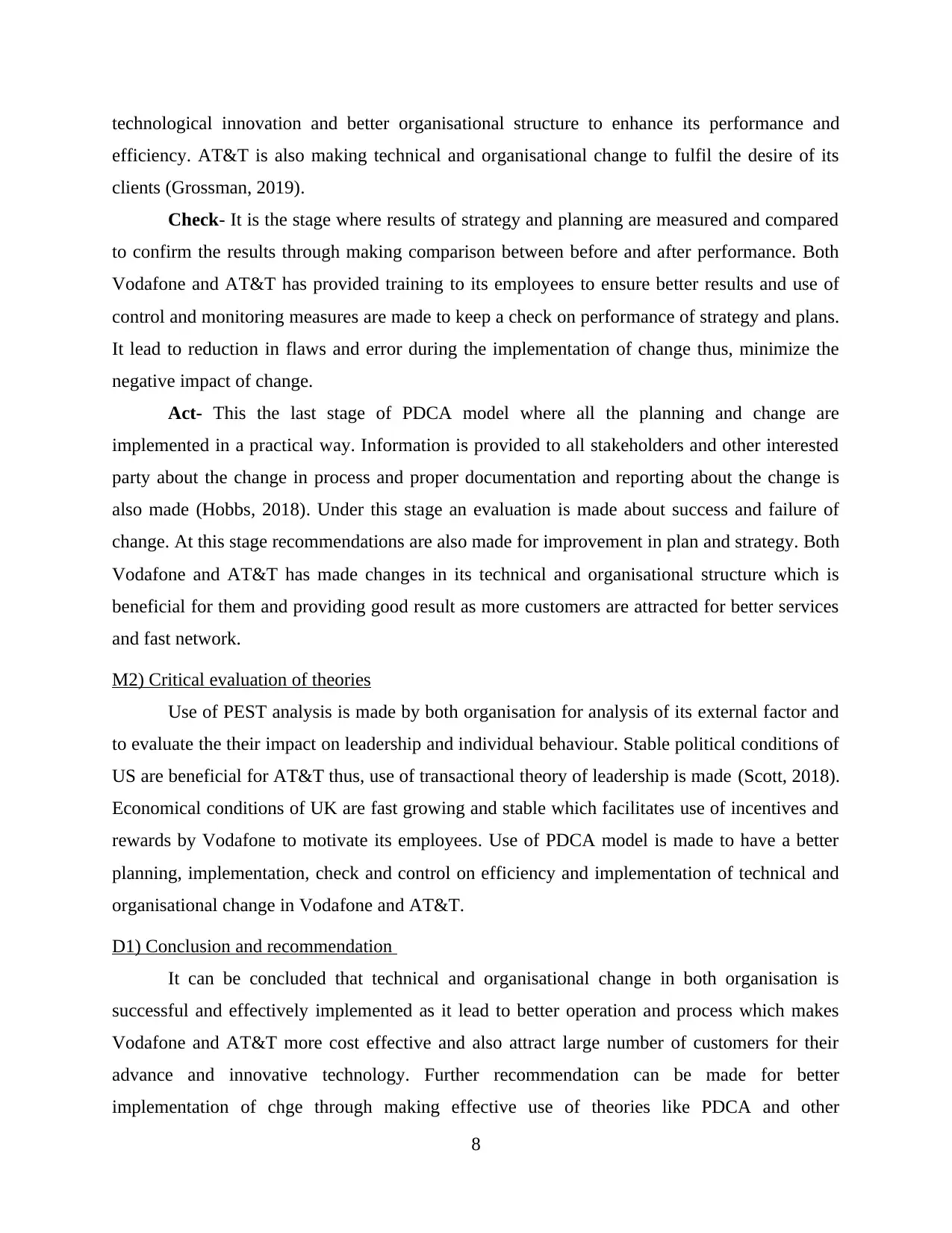
technological innovation and better organisational structure to enhance its performance and
efficiency. AT&T is also making technical and organisational change to fulfil the desire of its
clients (Grossman, 2019).
Check- It is the stage where results of strategy and planning are measured and compared
to confirm the results through making comparison between before and after performance. Both
Vodafone and AT&T has provided training to its employees to ensure better results and use of
control and monitoring measures are made to keep a check on performance of strategy and plans.
It lead to reduction in flaws and error during the implementation of change thus, minimize the
negative impact of change.
Act- This the last stage of PDCA model where all the planning and change are
implemented in a practical way. Information is provided to all stakeholders and other interested
party about the change in process and proper documentation and reporting about the change is
also made (Hobbs, 2018). Under this stage an evaluation is made about success and failure of
change. At this stage recommendations are also made for improvement in plan and strategy. Both
Vodafone and AT&T has made changes in its technical and organisational structure which is
beneficial for them and providing good result as more customers are attracted for better services
and fast network.
M2) Critical evaluation of theories
Use of PEST analysis is made by both organisation for analysis of its external factor and
to evaluate the their impact on leadership and individual behaviour. Stable political conditions of
US are beneficial for AT&T thus, use of transactional theory of leadership is made (Scott, 2018).
Economical conditions of UK are fast growing and stable which facilitates use of incentives and
rewards by Vodafone to motivate its employees. Use of PDCA model is made to have a better
planning, implementation, check and control on efficiency and implementation of technical and
organisational change in Vodafone and AT&T.
D1) Conclusion and recommendation
It can be concluded that technical and organisational change in both organisation is
successful and effectively implemented as it lead to better operation and process which makes
Vodafone and AT&T more cost effective and also attract large number of customers for their
advance and innovative technology. Further recommendation can be made for better
implementation of chge through making effective use of theories like PDCA and other
8
efficiency. AT&T is also making technical and organisational change to fulfil the desire of its
clients (Grossman, 2019).
Check- It is the stage where results of strategy and planning are measured and compared
to confirm the results through making comparison between before and after performance. Both
Vodafone and AT&T has provided training to its employees to ensure better results and use of
control and monitoring measures are made to keep a check on performance of strategy and plans.
It lead to reduction in flaws and error during the implementation of change thus, minimize the
negative impact of change.
Act- This the last stage of PDCA model where all the planning and change are
implemented in a practical way. Information is provided to all stakeholders and other interested
party about the change in process and proper documentation and reporting about the change is
also made (Hobbs, 2018). Under this stage an evaluation is made about success and failure of
change. At this stage recommendations are also made for improvement in plan and strategy. Both
Vodafone and AT&T has made changes in its technical and organisational structure which is
beneficial for them and providing good result as more customers are attracted for better services
and fast network.
M2) Critical evaluation of theories
Use of PEST analysis is made by both organisation for analysis of its external factor and
to evaluate the their impact on leadership and individual behaviour. Stable political conditions of
US are beneficial for AT&T thus, use of transactional theory of leadership is made (Scott, 2018).
Economical conditions of UK are fast growing and stable which facilitates use of incentives and
rewards by Vodafone to motivate its employees. Use of PDCA model is made to have a better
planning, implementation, check and control on efficiency and implementation of technical and
organisational change in Vodafone and AT&T.
D1) Conclusion and recommendation
It can be concluded that technical and organisational change in both organisation is
successful and effectively implemented as it lead to better operation and process which makes
Vodafone and AT&T more cost effective and also attract large number of customers for their
advance and innovative technology. Further recommendation can be made for better
implementation of chge through making effective use of theories like PDCA and other
8
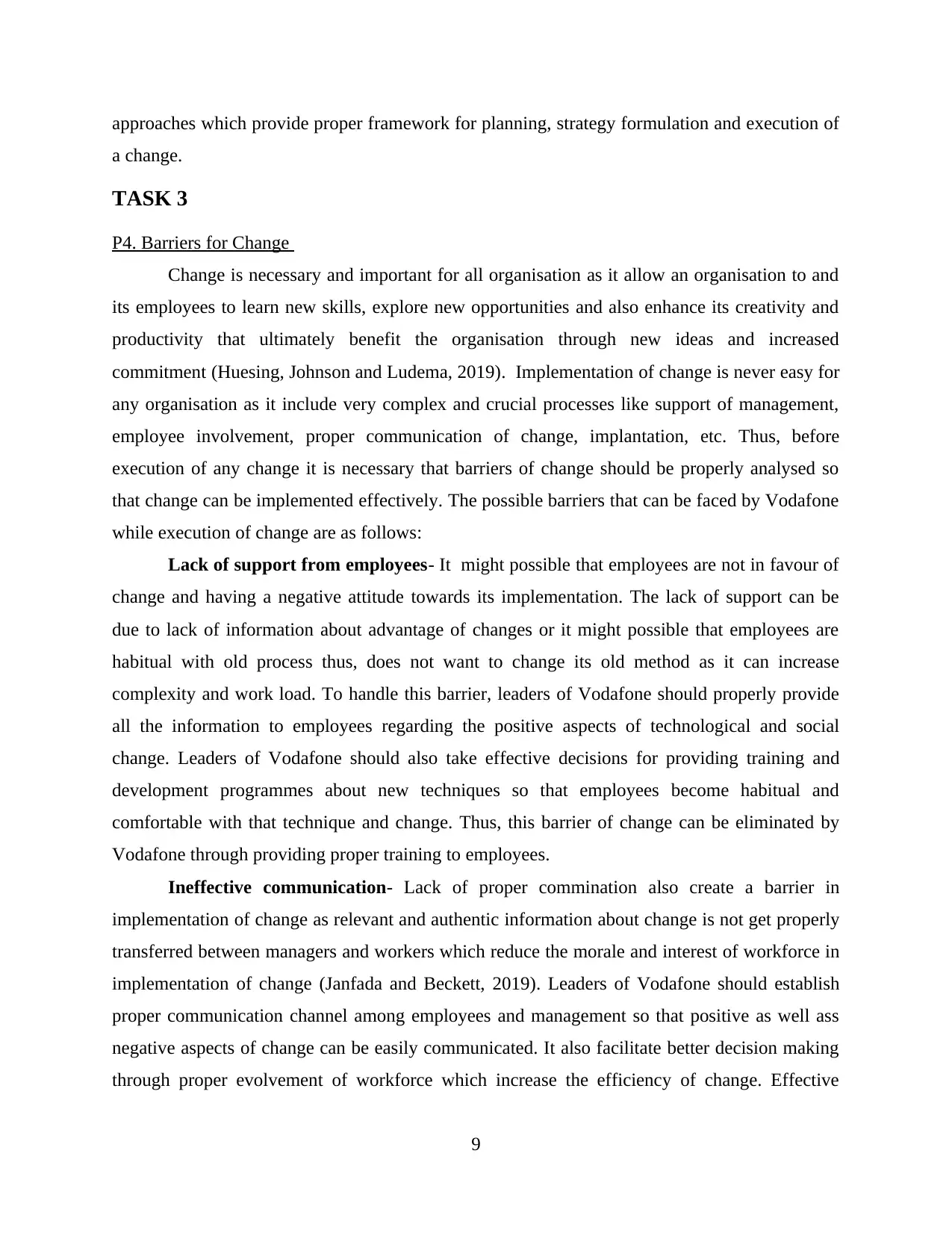
approaches which provide proper framework for planning, strategy formulation and execution of
a change.
TASK 3
P4. Barriers for Change
Change is necessary and important for all organisation as it allow an organisation to and
its employees to learn new skills, explore new opportunities and also enhance its creativity and
productivity that ultimately benefit the organisation through new ideas and increased
commitment (Huesing, Johnson and Ludema, 2019). Implementation of change is never easy for
any organisation as it include very complex and crucial processes like support of management,
employee involvement, proper communication of change, implantation, etc. Thus, before
execution of any change it is necessary that barriers of change should be properly analysed so
that change can be implemented effectively. The possible barriers that can be faced by Vodafone
while execution of change are as follows:
Lack of support from employees- It might possible that employees are not in favour of
change and having a negative attitude towards its implementation. The lack of support can be
due to lack of information about advantage of changes or it might possible that employees are
habitual with old process thus, does not want to change its old method as it can increase
complexity and work load. To handle this barrier, leaders of Vodafone should properly provide
all the information to employees regarding the positive aspects of technological and social
change. Leaders of Vodafone should also take effective decisions for providing training and
development programmes about new techniques so that employees become habitual and
comfortable with that technique and change. Thus, this barrier of change can be eliminated by
Vodafone through providing proper training to employees.
Ineffective communication- Lack of proper commination also create a barrier in
implementation of change as relevant and authentic information about change is not get properly
transferred between managers and workers which reduce the morale and interest of workforce in
implementation of change (Janfada and Beckett, 2019). Leaders of Vodafone should establish
proper communication channel among employees and management so that positive as well ass
negative aspects of change can be easily communicated. It also facilitate better decision making
through proper evolvement of workforce which increase the efficiency of change. Effective
9
a change.
TASK 3
P4. Barriers for Change
Change is necessary and important for all organisation as it allow an organisation to and
its employees to learn new skills, explore new opportunities and also enhance its creativity and
productivity that ultimately benefit the organisation through new ideas and increased
commitment (Huesing, Johnson and Ludema, 2019). Implementation of change is never easy for
any organisation as it include very complex and crucial processes like support of management,
employee involvement, proper communication of change, implantation, etc. Thus, before
execution of any change it is necessary that barriers of change should be properly analysed so
that change can be implemented effectively. The possible barriers that can be faced by Vodafone
while execution of change are as follows:
Lack of support from employees- It might possible that employees are not in favour of
change and having a negative attitude towards its implementation. The lack of support can be
due to lack of information about advantage of changes or it might possible that employees are
habitual with old process thus, does not want to change its old method as it can increase
complexity and work load. To handle this barrier, leaders of Vodafone should properly provide
all the information to employees regarding the positive aspects of technological and social
change. Leaders of Vodafone should also take effective decisions for providing training and
development programmes about new techniques so that employees become habitual and
comfortable with that technique and change. Thus, this barrier of change can be eliminated by
Vodafone through providing proper training to employees.
Ineffective communication- Lack of proper commination also create a barrier in
implementation of change as relevant and authentic information about change is not get properly
transferred between managers and workers which reduce the morale and interest of workforce in
implementation of change (Janfada and Beckett, 2019). Leaders of Vodafone should establish
proper communication channel among employees and management so that positive as well ass
negative aspects of change can be easily communicated. It also facilitate better decision making
through proper evolvement of workforce which increase the efficiency of change. Effective
9

communication also ensures proper guidance and supervision in Vodafone that motivates
employees for better execution of social and technological change in the organisation.
M3. Force field analysis
Vodafone is coming up with social and technological change in its organisation thus, it
become necessary for it to properly analysis the barriers and driving and resisting forces. For this
evaluation use of Force filed analysis is made.
Force field analysis
it is method used for evaluating and listing the forces some of which are against of
change while some forces favour the change (Saleh, 2019). The different deriving and restraining
forces in context with change made by Vodafone are provided below:
Driving Factors: These are the forces which are in favour of a change and drive a
organisation for easily adopting a change. In context of Vodafone, stable economic environment
and innovative social culture of UK are the driving force which creates positive environment for
brining technical and organisational changes to fulfil the desire of society. Desire of customers
for fast network is also important driver for change which lead to adoption of technical change
by Vodafone (Kotlar and Chrisman, 2019). Use of effective research and development is made
by Vodafone for proper execution of technical and organisational change. Proper training and
motivation is also provided by leaders to guide and direct its employees for better execution of
change which is also act as a driving factors for Vodafone.
Restraining forces- These factors creates barrier and restrict the change in an
organisation. These forces mainly reflects the problems and issues that can be faced by any
organisation while implementation of any change. For Vodafone, lack of support from
employees and ineffective communication channels are the restraining forces which hinder or
create issues in implementation of technical and organisational change. Ineffective
communication lead to interrupted flow or transfer of information which lead to creation of
chaos and conflicts. These issues can be solved by Vodafone through providing proper training
and establishing proper channels of communications in organisation so that changes can be made
easily.
D2) Critical evaluation of force field analysis
Force field analysis provide knowledge about various driving and restraining force which
provides an opportunity for organisation to take corrective action to meet and handle the
10
employees for better execution of social and technological change in the organisation.
M3. Force field analysis
Vodafone is coming up with social and technological change in its organisation thus, it
become necessary for it to properly analysis the barriers and driving and resisting forces. For this
evaluation use of Force filed analysis is made.
Force field analysis
it is method used for evaluating and listing the forces some of which are against of
change while some forces favour the change (Saleh, 2019). The different deriving and restraining
forces in context with change made by Vodafone are provided below:
Driving Factors: These are the forces which are in favour of a change and drive a
organisation for easily adopting a change. In context of Vodafone, stable economic environment
and innovative social culture of UK are the driving force which creates positive environment for
brining technical and organisational changes to fulfil the desire of society. Desire of customers
for fast network is also important driver for change which lead to adoption of technical change
by Vodafone (Kotlar and Chrisman, 2019). Use of effective research and development is made
by Vodafone for proper execution of technical and organisational change. Proper training and
motivation is also provided by leaders to guide and direct its employees for better execution of
change which is also act as a driving factors for Vodafone.
Restraining forces- These factors creates barrier and restrict the change in an
organisation. These forces mainly reflects the problems and issues that can be faced by any
organisation while implementation of any change. For Vodafone, lack of support from
employees and ineffective communication channels are the restraining forces which hinder or
create issues in implementation of technical and organisational change. Ineffective
communication lead to interrupted flow or transfer of information which lead to creation of
chaos and conflicts. These issues can be solved by Vodafone through providing proper training
and establishing proper channels of communications in organisation so that changes can be made
easily.
D2) Critical evaluation of force field analysis
Force field analysis provide knowledge about various driving and restraining force which
provides an opportunity for organisation to take corrective action to meet and handle the
10
Paraphrase This Document
Need a fresh take? Get an instant paraphrase of this document with our AI Paraphraser
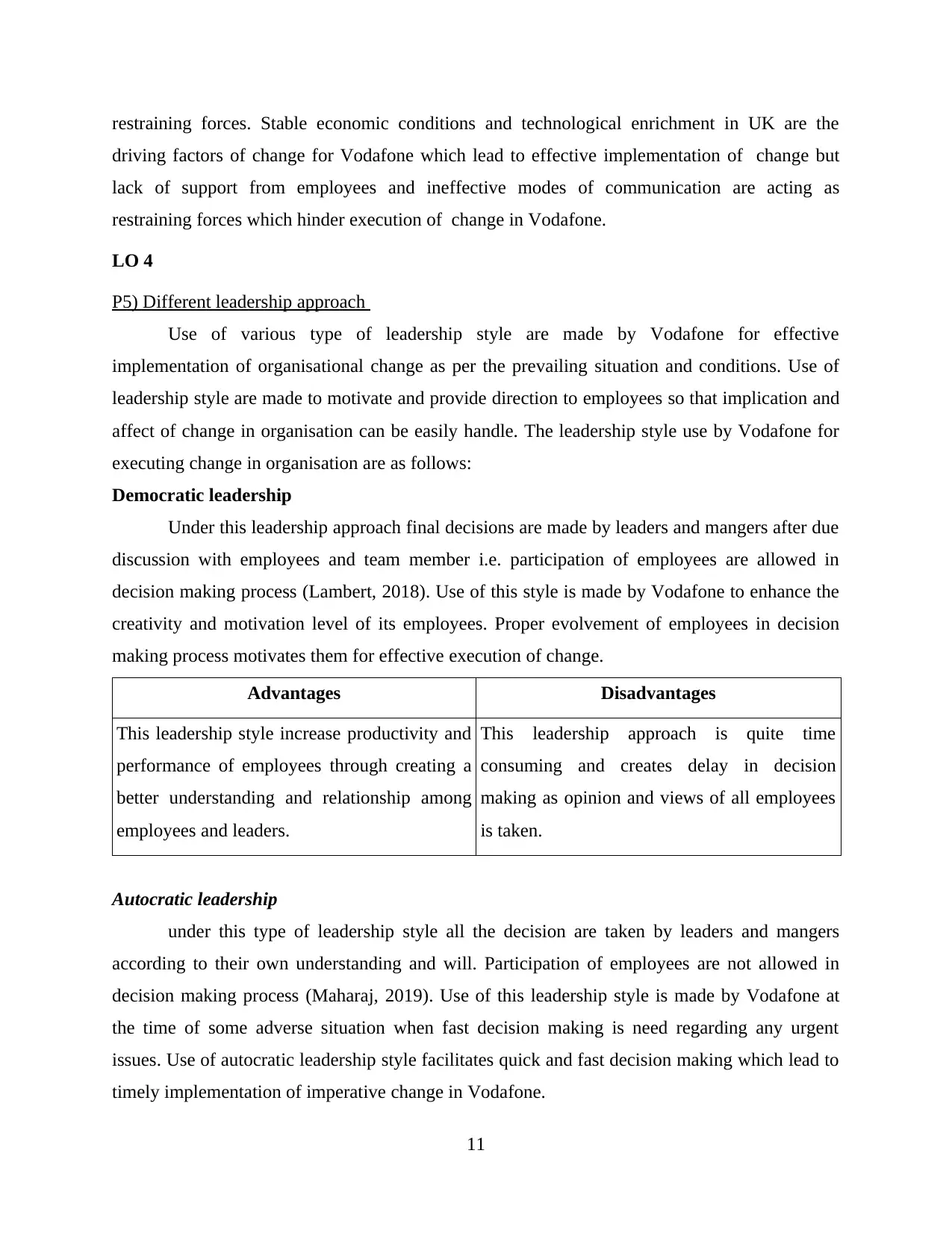
restraining forces. Stable economic conditions and technological enrichment in UK are the
driving factors of change for Vodafone which lead to effective implementation of change but
lack of support from employees and ineffective modes of communication are acting as
restraining forces which hinder execution of change in Vodafone.
LO 4
P5) Different leadership approach
Use of various type of leadership style are made by Vodafone for effective
implementation of organisational change as per the prevailing situation and conditions. Use of
leadership style are made to motivate and provide direction to employees so that implication and
affect of change in organisation can be easily handle. The leadership style use by Vodafone for
executing change in organisation are as follows:
Democratic leadership
Under this leadership approach final decisions are made by leaders and mangers after due
discussion with employees and team member i.e. participation of employees are allowed in
decision making process (Lambert, 2018). Use of this style is made by Vodafone to enhance the
creativity and motivation level of its employees. Proper evolvement of employees in decision
making process motivates them for effective execution of change.
Advantages Disadvantages
This leadership style increase productivity and
performance of employees through creating a
better understanding and relationship among
employees and leaders.
This leadership approach is quite time
consuming and creates delay in decision
making as opinion and views of all employees
is taken.
Autocratic leadership
under this type of leadership style all the decision are taken by leaders and mangers
according to their own understanding and will. Participation of employees are not allowed in
decision making process (Maharaj, 2019). Use of this leadership style is made by Vodafone at
the time of some adverse situation when fast decision making is need regarding any urgent
issues. Use of autocratic leadership style facilitates quick and fast decision making which lead to
timely implementation of imperative change in Vodafone.
11
driving factors of change for Vodafone which lead to effective implementation of change but
lack of support from employees and ineffective modes of communication are acting as
restraining forces which hinder execution of change in Vodafone.
LO 4
P5) Different leadership approach
Use of various type of leadership style are made by Vodafone for effective
implementation of organisational change as per the prevailing situation and conditions. Use of
leadership style are made to motivate and provide direction to employees so that implication and
affect of change in organisation can be easily handle. The leadership style use by Vodafone for
executing change in organisation are as follows:
Democratic leadership
Under this leadership approach final decisions are made by leaders and mangers after due
discussion with employees and team member i.e. participation of employees are allowed in
decision making process (Lambert, 2018). Use of this style is made by Vodafone to enhance the
creativity and motivation level of its employees. Proper evolvement of employees in decision
making process motivates them for effective execution of change.
Advantages Disadvantages
This leadership style increase productivity and
performance of employees through creating a
better understanding and relationship among
employees and leaders.
This leadership approach is quite time
consuming and creates delay in decision
making as opinion and views of all employees
is taken.
Autocratic leadership
under this type of leadership style all the decision are taken by leaders and mangers
according to their own understanding and will. Participation of employees are not allowed in
decision making process (Maharaj, 2019). Use of this leadership style is made by Vodafone at
the time of some adverse situation when fast decision making is need regarding any urgent
issues. Use of autocratic leadership style facilitates quick and fast decision making which lead to
timely implementation of imperative change in Vodafone.
11
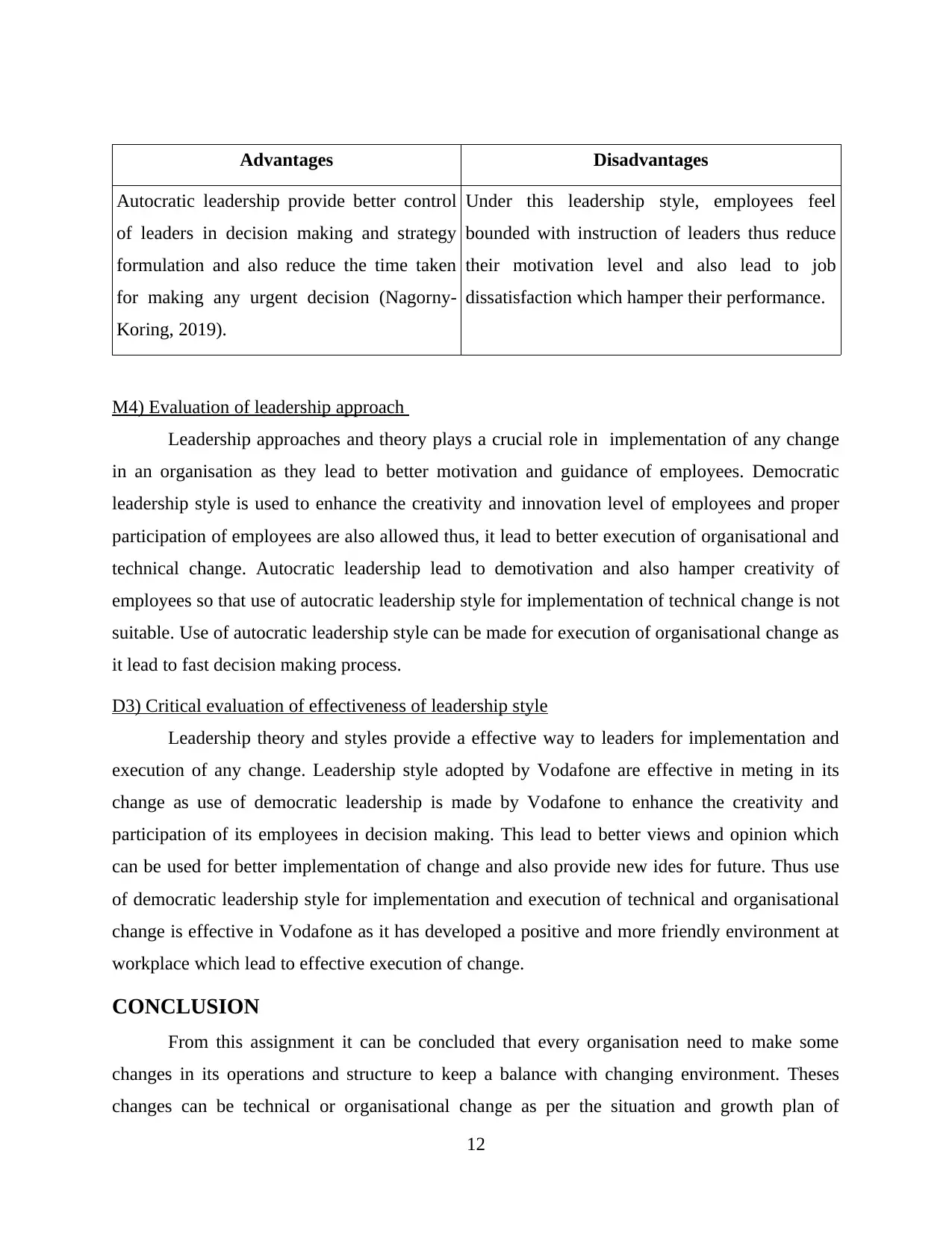
Advantages Disadvantages
Autocratic leadership provide better control
of leaders in decision making and strategy
formulation and also reduce the time taken
for making any urgent decision (Nagorny-
Koring, 2019).
Under this leadership style, employees feel
bounded with instruction of leaders thus reduce
their motivation level and also lead to job
dissatisfaction which hamper their performance.
M4) Evaluation of leadership approach
Leadership approaches and theory plays a crucial role in implementation of any change
in an organisation as they lead to better motivation and guidance of employees. Democratic
leadership style is used to enhance the creativity and innovation level of employees and proper
participation of employees are also allowed thus, it lead to better execution of organisational and
technical change. Autocratic leadership lead to demotivation and also hamper creativity of
employees so that use of autocratic leadership style for implementation of technical change is not
suitable. Use of autocratic leadership style can be made for execution of organisational change as
it lead to fast decision making process.
D3) Critical evaluation of effectiveness of leadership style
Leadership theory and styles provide a effective way to leaders for implementation and
execution of any change. Leadership style adopted by Vodafone are effective in meting in its
change as use of democratic leadership is made by Vodafone to enhance the creativity and
participation of its employees in decision making. This lead to better views and opinion which
can be used for better implementation of change and also provide new ides for future. Thus use
of democratic leadership style for implementation and execution of technical and organisational
change is effective in Vodafone as it has developed a positive and more friendly environment at
workplace which lead to effective execution of change.
CONCLUSION
From this assignment it can be concluded that every organisation need to make some
changes in its operations and structure to keep a balance with changing environment. Theses
changes can be technical or organisational change as per the situation and growth plan of
12
Autocratic leadership provide better control
of leaders in decision making and strategy
formulation and also reduce the time taken
for making any urgent decision (Nagorny-
Koring, 2019).
Under this leadership style, employees feel
bounded with instruction of leaders thus reduce
their motivation level and also lead to job
dissatisfaction which hamper their performance.
M4) Evaluation of leadership approach
Leadership approaches and theory plays a crucial role in implementation of any change
in an organisation as they lead to better motivation and guidance of employees. Democratic
leadership style is used to enhance the creativity and innovation level of employees and proper
participation of employees are also allowed thus, it lead to better execution of organisational and
technical change. Autocratic leadership lead to demotivation and also hamper creativity of
employees so that use of autocratic leadership style for implementation of technical change is not
suitable. Use of autocratic leadership style can be made for execution of organisational change as
it lead to fast decision making process.
D3) Critical evaluation of effectiveness of leadership style
Leadership theory and styles provide a effective way to leaders for implementation and
execution of any change. Leadership style adopted by Vodafone are effective in meting in its
change as use of democratic leadership is made by Vodafone to enhance the creativity and
participation of its employees in decision making. This lead to better views and opinion which
can be used for better implementation of change and also provide new ides for future. Thus use
of democratic leadership style for implementation and execution of technical and organisational
change is effective in Vodafone as it has developed a positive and more friendly environment at
workplace which lead to effective execution of change.
CONCLUSION
From this assignment it can be concluded that every organisation need to make some
changes in its operations and structure to keep a balance with changing environment. Theses
changes can be technical or organisational change as per the situation and growth plan of
12
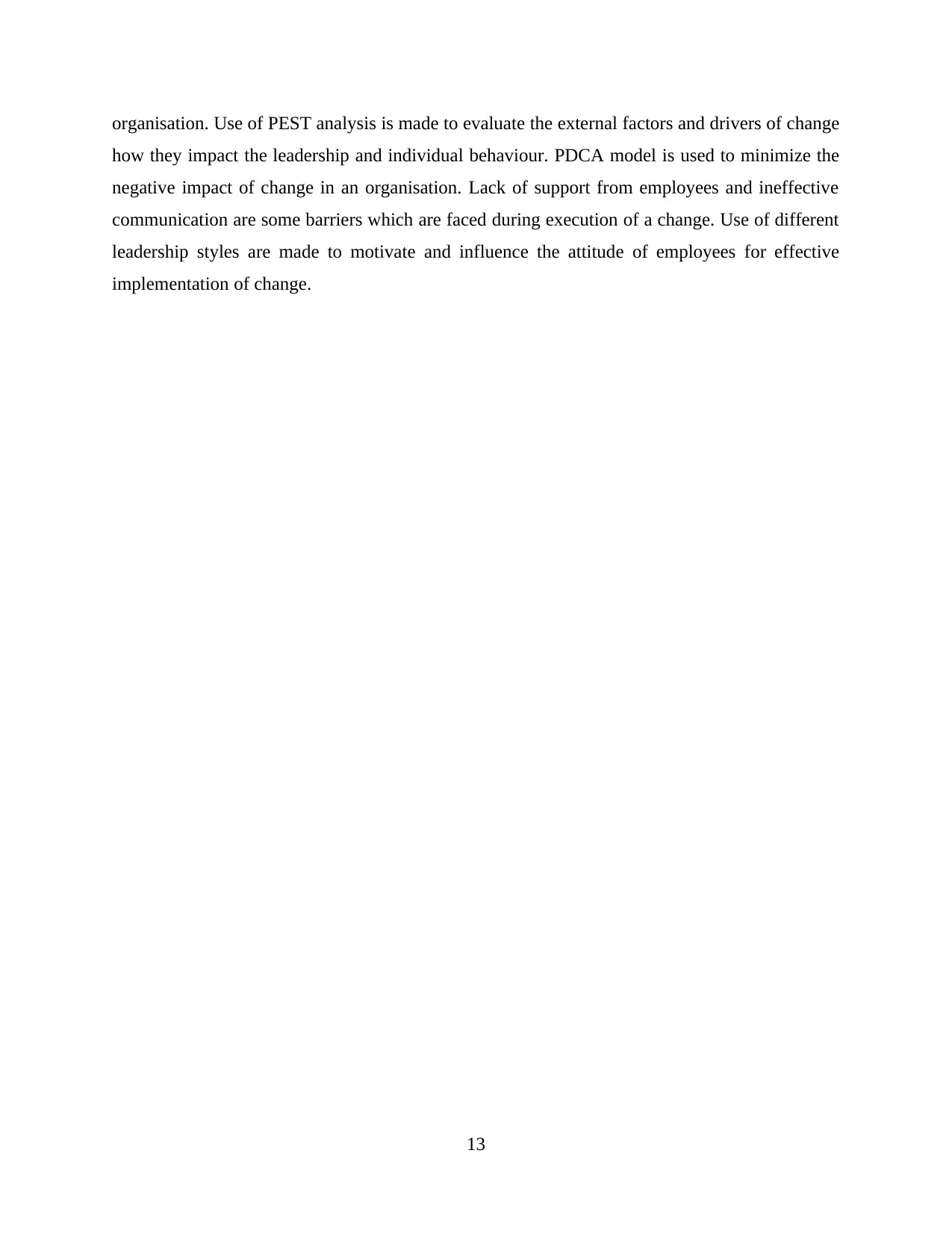
organisation. Use of PEST analysis is made to evaluate the external factors and drivers of change
how they impact the leadership and individual behaviour. PDCA model is used to minimize the
negative impact of change in an organisation. Lack of support from employees and ineffective
communication are some barriers which are faced during execution of a change. Use of different
leadership styles are made to motivate and influence the attitude of employees for effective
implementation of change.
13
how they impact the leadership and individual behaviour. PDCA model is used to minimize the
negative impact of change in an organisation. Lack of support from employees and ineffective
communication are some barriers which are faced during execution of a change. Use of different
leadership styles are made to motivate and influence the attitude of employees for effective
implementation of change.
13
Secure Best Marks with AI Grader
Need help grading? Try our AI Grader for instant feedback on your assignments.
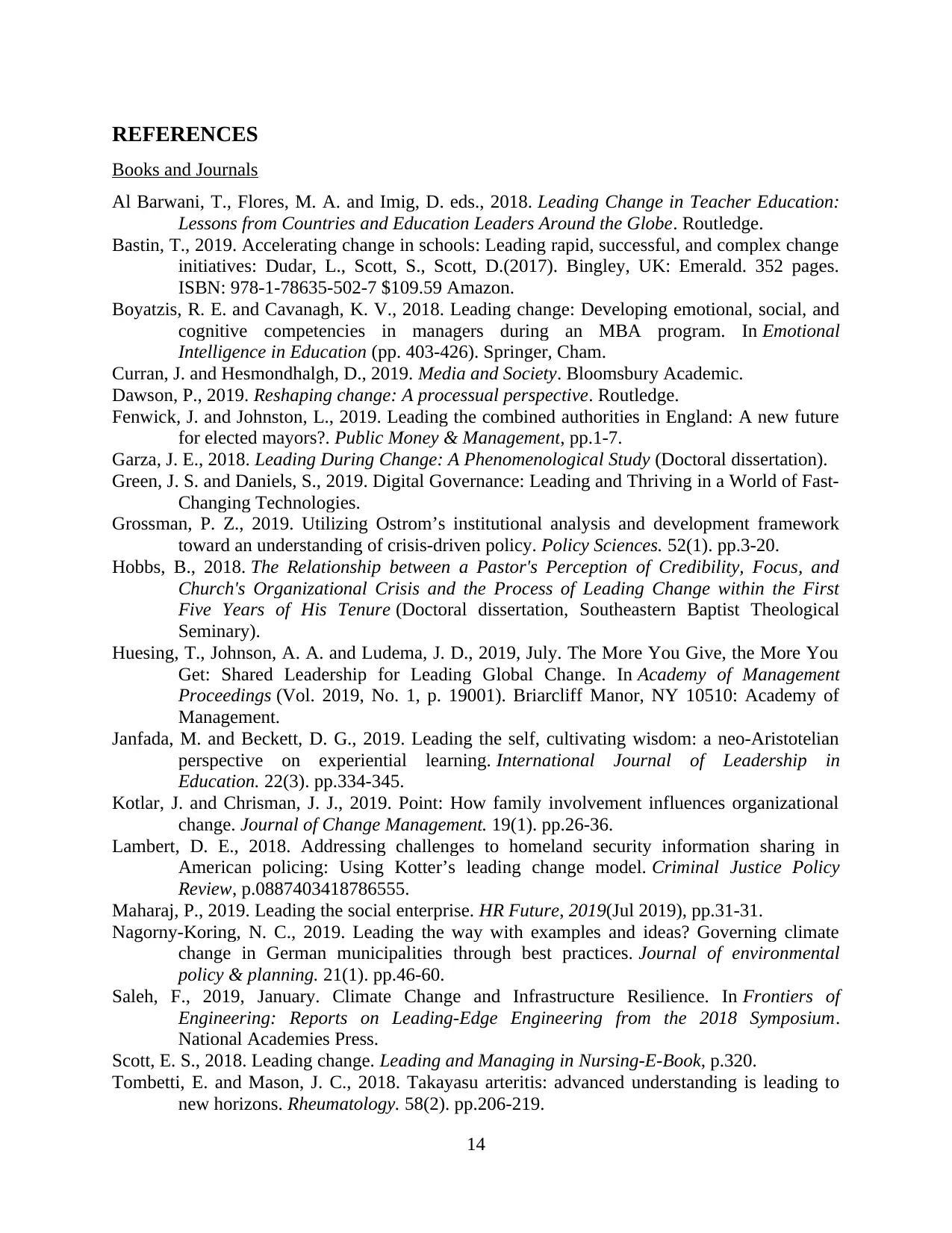
REFERENCES
Books and Journals
Al Barwani, T., Flores, M. A. and Imig, D. eds., 2018. Leading Change in Teacher Education:
Lessons from Countries and Education Leaders Around the Globe. Routledge.
Bastin, T., 2019. Accelerating change in schools: Leading rapid, successful, and complex change
initiatives: Dudar, L., Scott, S., Scott, D.(2017). Bingley, UK: Emerald. 352 pages.
ISBN: 978-1-78635-502-7 $109.59 Amazon.
Boyatzis, R. E. and Cavanagh, K. V., 2018. Leading change: Developing emotional, social, and
cognitive competencies in managers during an MBA program. In Emotional
Intelligence in Education (pp. 403-426). Springer, Cham.
Curran, J. and Hesmondhalgh, D., 2019. Media and Society. Bloomsbury Academic.
Dawson, P., 2019. Reshaping change: A processual perspective. Routledge.
Fenwick, J. and Johnston, L., 2019. Leading the combined authorities in England: A new future
for elected mayors?. Public Money & Management, pp.1-7.
Garza, J. E., 2018. Leading During Change: A Phenomenological Study (Doctoral dissertation).
Green, J. S. and Daniels, S., 2019. Digital Governance: Leading and Thriving in a World of Fast-
Changing Technologies.
Grossman, P. Z., 2019. Utilizing Ostrom’s institutional analysis and development framework
toward an understanding of crisis-driven policy. Policy Sciences. 52(1). pp.3-20.
Hobbs, B., 2018. The Relationship between a Pastor's Perception of Credibility, Focus, and
Church's Organizational Crisis and the Process of Leading Change within the First
Five Years of His Tenure (Doctoral dissertation, Southeastern Baptist Theological
Seminary).
Huesing, T., Johnson, A. A. and Ludema, J. D., 2019, July. The More You Give, the More You
Get: Shared Leadership for Leading Global Change. In Academy of Management
Proceedings (Vol. 2019, No. 1, p. 19001). Briarcliff Manor, NY 10510: Academy of
Management.
Janfada, M. and Beckett, D. G., 2019. Leading the self, cultivating wisdom: a neo-Aristotelian
perspective on experiential learning. International Journal of Leadership in
Education. 22(3). pp.334-345.
Kotlar, J. and Chrisman, J. J., 2019. Point: How family involvement influences organizational
change. Journal of Change Management. 19(1). pp.26-36.
Lambert, D. E., 2018. Addressing challenges to homeland security information sharing in
American policing: Using Kotter’s leading change model. Criminal Justice Policy
Review, p.0887403418786555.
Maharaj, P., 2019. Leading the social enterprise. HR Future, 2019(Jul 2019), pp.31-31.
Nagorny-Koring, N. C., 2019. Leading the way with examples and ideas? Governing climate
change in German municipalities through best practices. Journal of environmental
policy & planning. 21(1). pp.46-60.
Saleh, F., 2019, January. Climate Change and Infrastructure Resilience. In Frontiers of
Engineering: Reports on Leading-Edge Engineering from the 2018 Symposium.
National Academies Press.
Scott, E. S., 2018. Leading change. Leading and Managing in Nursing-E-Book, p.320.
Tombetti, E. and Mason, J. C., 2018. Takayasu arteritis: advanced understanding is leading to
new horizons. Rheumatology. 58(2). pp.206-219.
14
Books and Journals
Al Barwani, T., Flores, M. A. and Imig, D. eds., 2018. Leading Change in Teacher Education:
Lessons from Countries and Education Leaders Around the Globe. Routledge.
Bastin, T., 2019. Accelerating change in schools: Leading rapid, successful, and complex change
initiatives: Dudar, L., Scott, S., Scott, D.(2017). Bingley, UK: Emerald. 352 pages.
ISBN: 978-1-78635-502-7 $109.59 Amazon.
Boyatzis, R. E. and Cavanagh, K. V., 2018. Leading change: Developing emotional, social, and
cognitive competencies in managers during an MBA program. In Emotional
Intelligence in Education (pp. 403-426). Springer, Cham.
Curran, J. and Hesmondhalgh, D., 2019. Media and Society. Bloomsbury Academic.
Dawson, P., 2019. Reshaping change: A processual perspective. Routledge.
Fenwick, J. and Johnston, L., 2019. Leading the combined authorities in England: A new future
for elected mayors?. Public Money & Management, pp.1-7.
Garza, J. E., 2018. Leading During Change: A Phenomenological Study (Doctoral dissertation).
Green, J. S. and Daniels, S., 2019. Digital Governance: Leading and Thriving in a World of Fast-
Changing Technologies.
Grossman, P. Z., 2019. Utilizing Ostrom’s institutional analysis and development framework
toward an understanding of crisis-driven policy. Policy Sciences. 52(1). pp.3-20.
Hobbs, B., 2018. The Relationship between a Pastor's Perception of Credibility, Focus, and
Church's Organizational Crisis and the Process of Leading Change within the First
Five Years of His Tenure (Doctoral dissertation, Southeastern Baptist Theological
Seminary).
Huesing, T., Johnson, A. A. and Ludema, J. D., 2019, July. The More You Give, the More You
Get: Shared Leadership for Leading Global Change. In Academy of Management
Proceedings (Vol. 2019, No. 1, p. 19001). Briarcliff Manor, NY 10510: Academy of
Management.
Janfada, M. and Beckett, D. G., 2019. Leading the self, cultivating wisdom: a neo-Aristotelian
perspective on experiential learning. International Journal of Leadership in
Education. 22(3). pp.334-345.
Kotlar, J. and Chrisman, J. J., 2019. Point: How family involvement influences organizational
change. Journal of Change Management. 19(1). pp.26-36.
Lambert, D. E., 2018. Addressing challenges to homeland security information sharing in
American policing: Using Kotter’s leading change model. Criminal Justice Policy
Review, p.0887403418786555.
Maharaj, P., 2019. Leading the social enterprise. HR Future, 2019(Jul 2019), pp.31-31.
Nagorny-Koring, N. C., 2019. Leading the way with examples and ideas? Governing climate
change in German municipalities through best practices. Journal of environmental
policy & planning. 21(1). pp.46-60.
Saleh, F., 2019, January. Climate Change and Infrastructure Resilience. In Frontiers of
Engineering: Reports on Leading-Edge Engineering from the 2018 Symposium.
National Academies Press.
Scott, E. S., 2018. Leading change. Leading and Managing in Nursing-E-Book, p.320.
Tombetti, E. and Mason, J. C., 2018. Takayasu arteritis: advanced understanding is leading to
new horizons. Rheumatology. 58(2). pp.206-219.
14
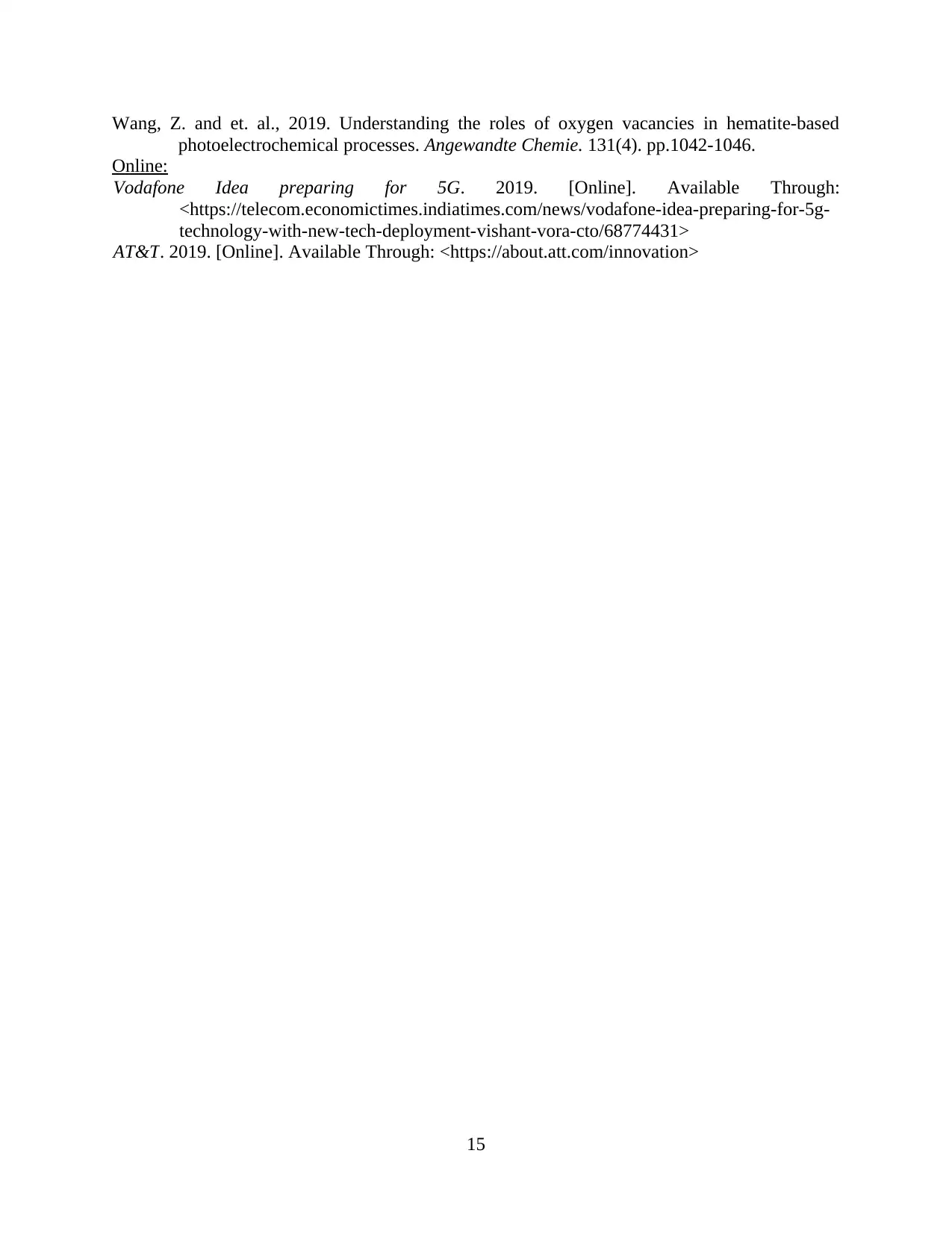
Wang, Z. and et. al., 2019. Understanding the roles of oxygen vacancies in hematite‐based
photoelectrochemical processes. Angewandte Chemie. 131(4). pp.1042-1046.
Online:
Vodafone Idea preparing for 5G. 2019. [Online]. Available Through:
<https://telecom.economictimes.indiatimes.com/news/vodafone-idea-preparing-for-5g-
technology-with-new-tech-deployment-vishant-vora-cto/68774431>
AT&T. 2019. [Online]. Available Through: <https://about.att.com/innovation>
15
photoelectrochemical processes. Angewandte Chemie. 131(4). pp.1042-1046.
Online:
Vodafone Idea preparing for 5G. 2019. [Online]. Available Through:
<https://telecom.economictimes.indiatimes.com/news/vodafone-idea-preparing-for-5g-
technology-with-new-tech-deployment-vishant-vora-cto/68774431>
AT&T. 2019. [Online]. Available Through: <https://about.att.com/innovation>
15
1 out of 18
Related Documents
Your All-in-One AI-Powered Toolkit for Academic Success.
+13062052269
info@desklib.com
Available 24*7 on WhatsApp / Email
![[object Object]](/_next/static/media/star-bottom.7253800d.svg)
Unlock your academic potential
© 2024 | Zucol Services PVT LTD | All rights reserved.





